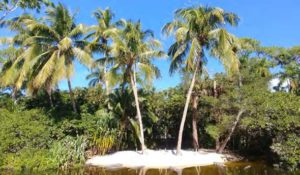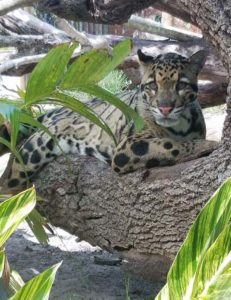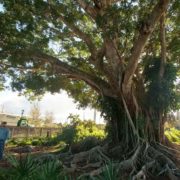How Zoo Horticulture Works
by Danielle L. Green, Naples Zoo Director of Gardens and Grounds
 Zoo horticulture is a unique blend of specialties that work with plants but often include skills in arboriculture.
Zoo horticulture is a unique blend of specialties that work with plants but often include skills in arboriculture.
A “zoo arborist” shares many skills and tree care goals with a municipal arborist but perform under a unique set of circumstances not often encountered in a municipal setting.
The life of a tree in the zoo environment can be tough. Thankfully, many tools and techniques exist that can improve soil and maintain proper tree health. At Naples Zoo at Caribbean Gardens in Naples, Florida, we have a unique combination of historical and tropical specimens that tell a story about the property as well as create a lush and beautiful backdrop for the animals and exhibits.
Many of our specimen trees date back to the early 1900s, planted by Dr. Henry Nehrling, and require specialized care regimens. Our climate allows for many tropical and subtropical species that serve many functions: beauty, shade for animals and guests, food for the animals to browse, perching sites for birds, scratching posts for tigers, and “furniture” that encourages animals to explore and be active in their exhibit habitat.
Managing the tree canopy in a zoo environment requires organization and consistent monitoring. Safety of the animal collection and the zoo guests is always a priority.
 Frequent inspections and documentation serve to ensure specimens are healthy and concerns are addressed promptly. Access to many specimens can be difficult because of adjacent structures such as restrooms, playgrounds, food areas, or animal exhibits…or animals decide they do not want to shift inside holding areas!
Frequent inspections and documentation serve to ensure specimens are healthy and concerns are addressed promptly. Access to many specimens can be difficult because of adjacent structures such as restrooms, playgrounds, food areas, or animal exhibits…or animals decide they do not want to shift inside holding areas!
Coconut removal over the alligator exhibit is always an adventure! Tree work such as pruning or root therapy requires specific planning and good communication amongst all departments. Most tree care activities impact the guest experience and sometimes require moving of animals to facilitate work.
Protecting trees from animals browsing, climbing, or scratching within an exhibit is a challenge for the zoo arborist different from that of a municipal or residential arborist. Many creative solutions exist such as using boulders or other objects to distance animals for the trees, flashing materials installed along the trunk, or managing the tree size inside the exhibit to contain animals if they do interact with the trees.
Signage and interpretation of the tree work being performed can serve to educate zoo guests and even staff on proper pruning, plant healthcare techniques, and pest and disease control
.Signage also educates zoo guests about how some trees species provide browse for the animals. In many cases, pruning debris is offered to animals like giraffe as part of their daily enrichment or a limb removal becomes a perch for a bird in the collection. Each species offered to animals must be approved by the veterinarian staff.
Soil compaction is a common issue in the zoo environment. Many tree specimens are located between exhibits, adjacent to public pathways and facilities, and within event spaces. This means they are subject to constant foot traffic from guests, staff, zoo animals, and construction activities that compact the soil.
Employing technology and systems developed for the arbor industry such as air-powered excavators and pressurized injection systems are used at the zoo to reverse soil compaction issues and get fertilization to the root system. This is extremely important in exhibits with large animals such as elephant and rhino as they compact soil easily.
Maintaining a healthy urban forest in a zoo is an essential part of caring for wildlife, educating guests, and offering a beautiful garden to visit.




Leave a Reply
Want to join the discussion?Feel free to contribute!